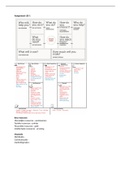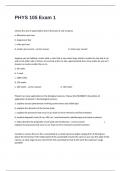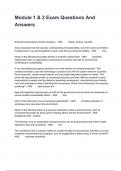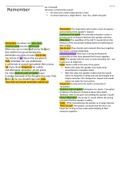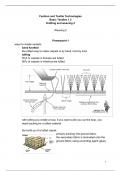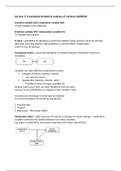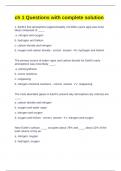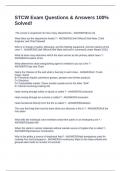Global markets require one set of high quality financial reporting standards (US GAAP and IFRS) for
cost efficient preparation, attract international financing opportunities (firm) and comparability
(investors).
Financial accounting, identifying, measuring and communicating financial information about
economic entities to interested parties. Provide financial information that is useful to users in making
decisions related to providing resources to the entity.
Reason for one set of high quality reporting standards: comparability and cost efficient preparation,
attract international financing opportunities.
Capital allocation, the process of determining how and at what cost money is allocated among
competing interests. Investors need relevant and faithful information, therefore IFRS is developed.
Accrual-basis accounting, record events in the periods in which it occurs, rather than in the period it
receives or pays cash.
IASB issues IFRS, focusses on investors and lenders. Principle based (you can interpret the rules in
many ways)(downside, more likely to get sued). 2005: European firms have to report consolidated
financial statements in accordance with IFRS.
Challenges with IFRS: the expectations gap (what the public thinks accountants should do and what
accountants think they can do (e.g. they can’t detect fraud, while lots of people want them to)) is
difficult to close. Significant issues: non-financial measurements, forward-looking information, soft
assets and timeliness.
Reporting entity, an entity that is required, or chooses, to prepare financial statements. Financial
statements can be: consolidated (parent company and subsidiaries), unconsolidated (parent
company only) and combined (two or more entities without parent-subsidiary relationship).
Basic elements of financial statements: assets (economic resource, a right that has the potential to
produce economic benefits), liabilities (obligation, a duty or responsibility that the entity has no
practical ability to avoid), equity (assets – liabilities), income and expenses.
Ch 2
Conceptual framework, enables the IASB to issue more useful and consistent pronouncements over
time. It enhances comparability among companies’ financial statements. Makes it more quickly to
solve new practical problems by referring to an existing framework of basic theory.
IFRS and the conceptual framework provide managers with discretion in accounting choices. The
auditor’s opinion answers the questions: does the financial info provide a true and fair view and is it
in accordance with IFRS?
First level – basic objective.
Second level – fundamental concepts. Make decisions based on which alternative provides the most
useful info for decision-making purposes (Decision-usefulness). Useful info must be (only constraint:
cost):
, 1. Relevant: Predictive, Confirmatory and Material (it must
make a difference, consider both quantitative and
qualitative factors)
2. Faithful representation: Complete, Neutral (don’t select
info to favor one set of interested parties over another),
Free from error.
3. And some enhancing qualities: Comparable (and
consistent), Verifiable (when independent measures
obtain similar results), Timely (info is available before it
loses its capacity to influence decisions), Understandable.
Third level – concepts that implement level one. Assumptions:
1. Economic entity assumption, economic activity can be identified with a particular unit of
accountability. So, a company keeps its activity separate from its owners. Could also be
about separate departments in a company.
2. Going concern, assume companies have a long life. Only where liquidation appears imminent
is the assumption inapplicable.
3. Monetary unit, means that money is the common denominator of economic activity.
4. Periodicity, a company can divide its economic activities into artificial time periods. But, the
quicker a company releases the info, the more likely the info have errors (trade-off between
relevance and faithful representation).
5. Accrual basis, record transaction in the periods in which the event occurs (matching).
Principles of accounting:
1. Measurement principles: historical cost (what did we pay in the past. Disadv: no
consideration of current value) and current value (fair value, value in use and current cost).
2. Revenue recognition principle. Recognition, the process of capturing for inclusion in the
statement of financial position to the statement(s) of financial performance, an item that
meets the definition of an asset, a liability, equity, income or expenses.
Derecognition, the removal of all or part of a recognized asset or liability from an entity’s
statement of financial position.
3. Expense recognition principle (product and period cost).
4. Full disclosure principle, provide information that is of sufficient importance to influence the
judgment of an informed user (recognition, derecognition).
Cost constraint, companies must weigh the costs of providing info against the benefits from using it.
Ch 3
AIS, collects and processes transaction data and then disseminates the financial info to interested
parties.
Assets = Liabilities + Equity (= Share Capital + Retained Earnings – Dividend + Revenues – Expenses)
Accounting cycle:
1. Transactions (relevant info and faithful representation). Daily
2. Journalizing (boeken) and posting on T-accounts
3. Trial balance (lists ALL T-accounts) Regularly (annual, quarterly)
4. Adjusting entries and adjusted trial balance
, 5. Financial statements End of period (annual)
6. Closing
Trial balance, list of accounts and their balances at a given time, debit and credit must be equal,
doesn’t prove that a company recorded all transactions or that the ledger is correct.
Adjusting entries (follows from matching principle):
- Deferrals (cash before transaction): Prepaid expenses (depreciation (contra asset
accumulated depreciation)) and Unearned revenues
- Accruals (cash after transaction): Accrued revenues and Accrued expenses (interest, wages
and bad debt (cr contra asset allowance for doubtful accounts, deb bad debt expense)).
Closing, reduces the balance of temporary (expenses, revenue) accounts to zero. Book on income
summary account. Do NOT close dividends, they aren’t expenses, close them against RE.
Overview of statements: P3-36.
Ch 4
Usefulness of the income statements:
1. Evaluate the past performances
2. Provide a basis for predicting future performance
3. Help assess the risk or uncertainty of achieving future cash flows
Limitations income:
1. Companies omit items from the income statement that they cannot measure reliably (e.g.
unrealized earnings)
2. Numbers are affected by the accounting methods employed (how do you value inventory)
3. Income measurement involves judgement (how long do you depreciate)
Earning management, planned timing of revenues, expenses, gains and losses
to smooth out bumps in earnings (NOT FRAUD). Reasons (earnings can be of
different quality) (Healy & Wahlen):
- compensation (bonussen), meet or beat investors’ expectations
- Regulatory motivations: government (decrease attention)
- Debt contracts (manage earnings targets in debt contracts).
Negatively affects the quality of earnings if it distorts the info in a way that is less useful for
predicting future earnings and cash flows. So, earning is not one number.
Result of discretion: earnings can be of different quality. One time items decrease the ability to
predict future performance, risks and uncertainty.
Income statements, measures the success of a company’s operations for a given period of time.
(transaction approach, because net income results from revenue, expense, gain and loss
transactions)(can be condensed, so just add up all revenues), components: P4-7


